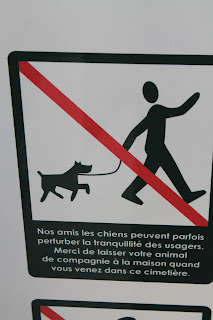Zurück in die Katakomben, nun in jene, die heute die Metro sind, und ca 20 min später steigen wir wieder auf, auf den Blvd de Clichy, von da in die Rue de Caulaincourt, die uns quer über den Friedhof von Montmartre führt, und zwar in luftiger Höhe, also zurück und noch mal von vorne. Nachdem wir den Eingang gefunden haben, stehen wir nun unter der Hochstraße, die Grabmäler reichen zum Teil bis an die Unterseite der Stahlkonstruktion der Brücke. Ewige Ruhe?
Nun, mal sehen, was es zu sehen gibt, kleine Grabsteine, große Grabmale, Gräber von 1825 und 2012, Gräber von Alten und Jungen, Bäume, Gräser, Sträucher, Blumen, Katzen, eine Symphonie in Stein und Botanik.
Suchen wir nun das Grab von Heinrich Heine, deutscher Dichter, Journalist, Schriftsteller, politisch engagiert, kritisch, Jude, also Aussenseiter in dem Land aus dem er fortging, fand er in Paris seine neue Heimat und auch seine letzte Ruhestätte, zusammen mit Frau Heine, wie auf ihrem gemeinsamen Grabmal vermeldet wird.
Und dann kamen die Männer mit den Glocken, um die letzte Ruhe der Toten zu stören, oder ihnen mitzuteilen, dass sie bald wieder unter sich sind, den der Friedhof wird nun geschlossen und wer nicht zum Ausgang strebt, bleibt über Nacht. Dann, ja, dann gehen wir, denn wir haben für die Nacht schon andere Pläne.
Zuerst aber überqueren wir den Friedhof erneut und besteigen nun den Berg des Martyriums MontMartre), na ja, so schlimm war der Aufstieg dann doch nicht. Also für uns nicht, für die, die einst zum Galgenberg aufsteigen mussten, weil sie eine Verabredung mit dem Herrn in der schwarzen Kapuze hatten, war das sicher anders. Heute sind die ehemalige Hinrichtungsstätte und die, nunmehr geschlossenen, Kalksteinbrüche eine beliebte Wohngegend und ein Highlight für die Besucher der Stadt. Vor allem wegen der Basilika Sacre Coeur, einem imposanten, architektonisch mehr als interessantem Bau, der wie eine faszinierende Mischung aus romanischem, spätgotischem, byzantinischem Baustil und einer Hochzeitstorte daherkommt. Vom Vorplatz der Kirche aus und auch von den Terrassen unterhalb haben wir einen schönen Rundumblick auf die Stadt, nach dessen Genuss wir die 500 Treppenstufen hinabsteigen und verlassen das ehemalige Kommunarden- und Künstlerviertel und gehen ins Hotel zum Abendessen.
Back into the catacombs, into those, wich are the Metro now adays and 20 min later we rise again, this time at Blvd de Clichy, turning in the Rue Coulaincourt, wich is leading us over the cemetery of Montmarte, at a dizzy high, that means going back and start again. Finally we found the entry and were standing now down under the elevated road and some of the anchient tombs nearly touch the underneath of the steel construction of the bridge. Eternal rest?
Let´s see what there is to be seen. Small gravestones and giant tombs, graves from 1825 and 2012, graves from old and young, tress, weed, bushes, flowers, cats, a symphonia in stone and botany.
We search for the grave of Heinrich Heine, a german poetrist, writer, journalist, engagé, critical, Jew, that means a pariah in the land, wich he left for finding him a new home in Paris and even here he was laid to rest. together with Mrs. Heine, like the monument told.
And now the men with the bells came, to wake up the dead or the tell them, that soon they´ll be among themselfs again, because the cemetery will be closed soon, and all those not heading for the exit have to spend the night there. We have other plans for tonight, so we leave.
At first we cross the cemetery once more and climb up the mount of the martyrdom (MontMartre), the ascent was not that heavy, not for us, but maybe for those in former times, who had to climb the gallows hill for their appointment with the man with the hood. Today the old place of execution and the, now closed, chalk pit are popular living areas and a highlight for the visiters of the city, esp. because of the Basilica of Sacre Coeur, an impressive, and architectural very interesting construction made of romanic, late gothic, byzantine style and a wedding cake. From the place infront of the curch and the terraces below we have a great look around at the city of Paris, after that enjoyment we step down the 500 steps and leave the neighbourhood of artists and communards and go for our dinner into the hotel.






















































Keine Kommentare:
Kommentar veröffentlichen